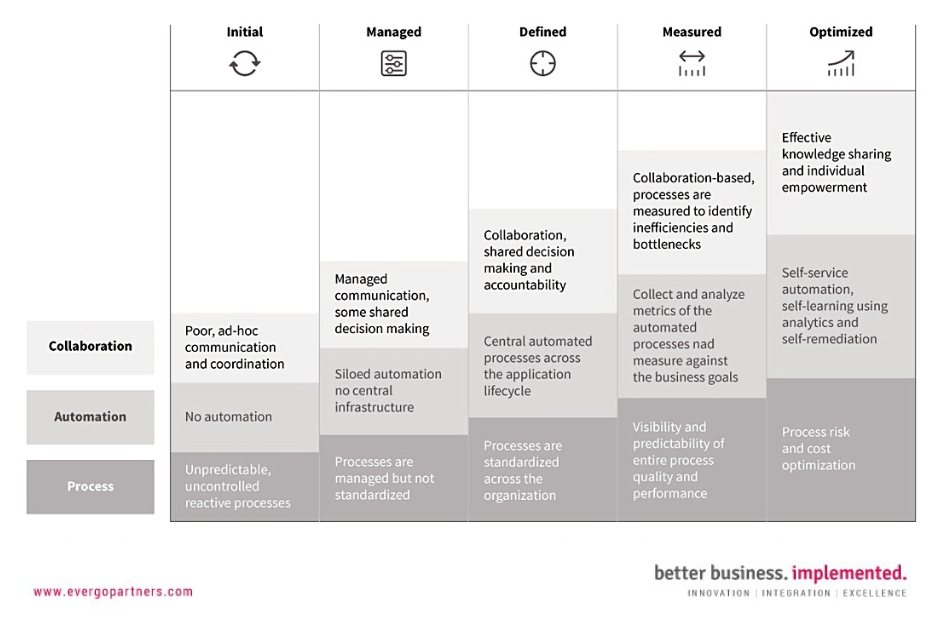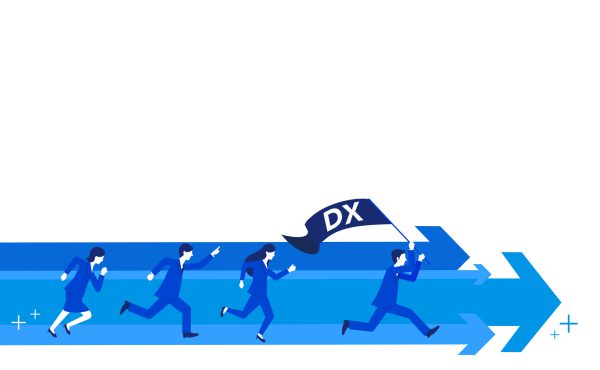Introduction
ITIL or Information Technology Infrastructure Library is the most widely accepted industry standard. ITIL provides the most comprehensive set of Best Practices for IT Service Management. Some of the core best practices focus on Service Strategy, Design, Transition, Support and Continual Improvement. It is critical to identify and setup the core Best Practices model specific to the IT supplier model such as 100% insourced or not dependent on any third-party process or function, hybrid with mix of internal and external process or function suppliers, fully outsourced, and/or a model where the goal is to provide outsourcer or managed process or function services to internal or external clients.
Five steps to success
ITIL assessment need can evolve over time to identify and improve best practices for the IT organization. Internal or external customer feedback provides the most insight into the capability scope and priority. It is often important to follow through with the assessment to establish a base line for any analysis and improvement plan. Below simple steps focus on easy to follow ITIL assessment model.
Identify core processes or functions
Every organization must know its capabilities. ITIL framework identifies Incident, Problem, Change, Configuration, Request Fulfillment, Knowledge, SLM, Event, Capacity, Availability, Supplier Management, Metrics & Reporting, and IT Service Continuity as the major processes or functions. All are important but there few that stand out: Incident, Problem, Change and Configuration processes are the foundation of most day to day activities in any global IT organization. Identifying and defining the most important processes and functions within your IT organization provides a structured approach to forming proper Service Strategy that enables Proactive Operations and structured Service/Process Transformations.
Complete knowledge of core processes or functions may be not available immediately due to high complexity and so called Hair Ball Systems Architecture without centralized knowledge repository. This process may take more than expected, but it is crucial for subsequent discussion with business and later transformation planning.
Identify your business strategy and goals
After the core processes and functions are defined the assessment may concentrate on capturing the expectations of the business. Main areas to be discussed with the business/customers include but are not limited to competitive needs, emerging markets, and governance constrains. Open discussions with executives should highlight most important aspects of business strategy and goals. Multiple meetings and further analysis with subject matter experts for specific area may be required to clearly identify business needs. This exercise will provide terrific basis for future Service Strategy planning meetings with the business.
Assess the current state – the maturity level

There are 5 levels of maturity within ITIL framework. Initial level 0 described as general lack and/or partial absence of process or function where there is no defined structure nor responsibilities which leads lack of consistency. Level 1 is characterized by no governance over the processes or function, only some records of activity exist depending on skills of the current participant, and no automation is in place. Level 2 is characterized by some degree of management commitment, participant’s roles are recognized but not clearly defined or documented, and operations are still on ad-hoc basis. Level 3 is characterized by visible management commitment, services and process roles are assigned to knowledgeable and trained participants, and there is some level of automation within the organization. Level 4 processes or functions are stable and rarely fail, documentation is complete and covers all aspects of the organization, and great deal of pre-emptive measures and continual improvement plans are in place. Level 5, the so called the optimized maturity level, is characterized by effective control, governance and focus visible throughout all levels of the IT organization.
During the maturity assessment it is most important to develop a set of criteria or questions that will cover all aspects of the core processes or functions identified in IT organization and verify them against the business strategy and goals. This step requires full commitment to perform complete study and verification of all processes in scope. It is very likely that some processes have higher maturity than others. This is normal, although the goal is always to get the Level that is acceptable by the business and benchmark each year to ensure progress and satisfy the business customers.
Develop transformation plan
Transition plan should be developed based on the priorities identified by the business strategy. There might be some processes or functions that are pre-requisites for others and although they are not the priority for the business, they must be implemented first. Communication is crucial for proper development of the transformation plan. Additionally, it is important to secure the support of major stakeholders to allow time for clear identification of all action items that need to become part of the transformation plan development such as resources, time, and focus. Finally, the integral part of the transformation plan must be obligatory re-assessment at least every year to ensure and verify progress.
Implement the findings and verify continually
It is not enough to perform the assessment and to create transformation plan. The most important work begins with the implementation. Remember to hold frequent status meetings and cheer up your team. Implementation is not easy and you are likely to face roadblocks. Perseverance and focus will produce results and full buy-in from stakeholders.
Benefits for Maturity Assessment
Maturity assessment level must honestly provide an answer to the most important question “What level of control the organization has over its own processes and functions?” For instance, any organization that uses information technology has to deal with incidents. Typically, the organization provides a function such as a service desk to which users can report incidents and from which they can receive help. The service desk can provide support without having any process for doing so and without any knowledge of IT service management. However, without a defined process for managing incidents, activities such as logging, prioritizing, diagnosing and resolving are likely to take longer and be less effective.
By adopting the following process controls, the organization can ensure that process activities are undertaken consistently, efficiently and effectively wherever they are conducted. These process controls include:
- Having a defined policy and agreed objectives
- Appointing an owner accountable for the process across the entire organization
- Providing appropriate procedural documentation
- Communicating awareness of the process to all users and stakeholders.
Identifying the maturity level will itemize the gaps which then can be measured and closed. Understanding the current level enables the organization to take control of the situation and proactively drive the desired goals with clear focus. Maturity level derived based on objective study of the organizations capabilities for each core process or function can provide clear insight into i.e. what is the value of each process or function, what return can be gained by improving, and most importantly how a process or function could be improved.
Most important benefits of setting the base line for each core process or function during the Maturity Assessment include clear identification of:
Service Catalogue Management
- Greater control over all processes or functions
- Clear visibility of value IT provides to the business
- Enables to set common expectations and goals for IT and business
- Facilitates better planning and allocation of resources.
Availability Management
- Higher IT service availability
- Improved customer satisfaction
- Reduced overall IT operational cost
- Improved IT organization image and employee morale.
Incident Management
- Clear procedures on various priority incidents
- Service stability improvement
- Reduced impact on business operations through timely resolution
- Improved user satisfaction.
Final Remarks
The above are only some benefits of performing ITIL Maturity Assessment. They can be enhanced through continual improvement process instilled in each identified service that IT organization offers. Maturity Assessment provides detailed insight into the improvement strategy direction and verification of the progress. Identification of processes or functions and deciding on the approach one process at a time vs. grouping processes is crucial for successful implementation.
Finally, there will be several perspectives on each process: that of the process owner, the process manager(s), the process practitioners, and the customers and users of the process. It is important that all these roles contribute to the maturity assessment exercise. Investment in ITIL assessment will pay off and allow higher degree of cooperation with the business and the clients




